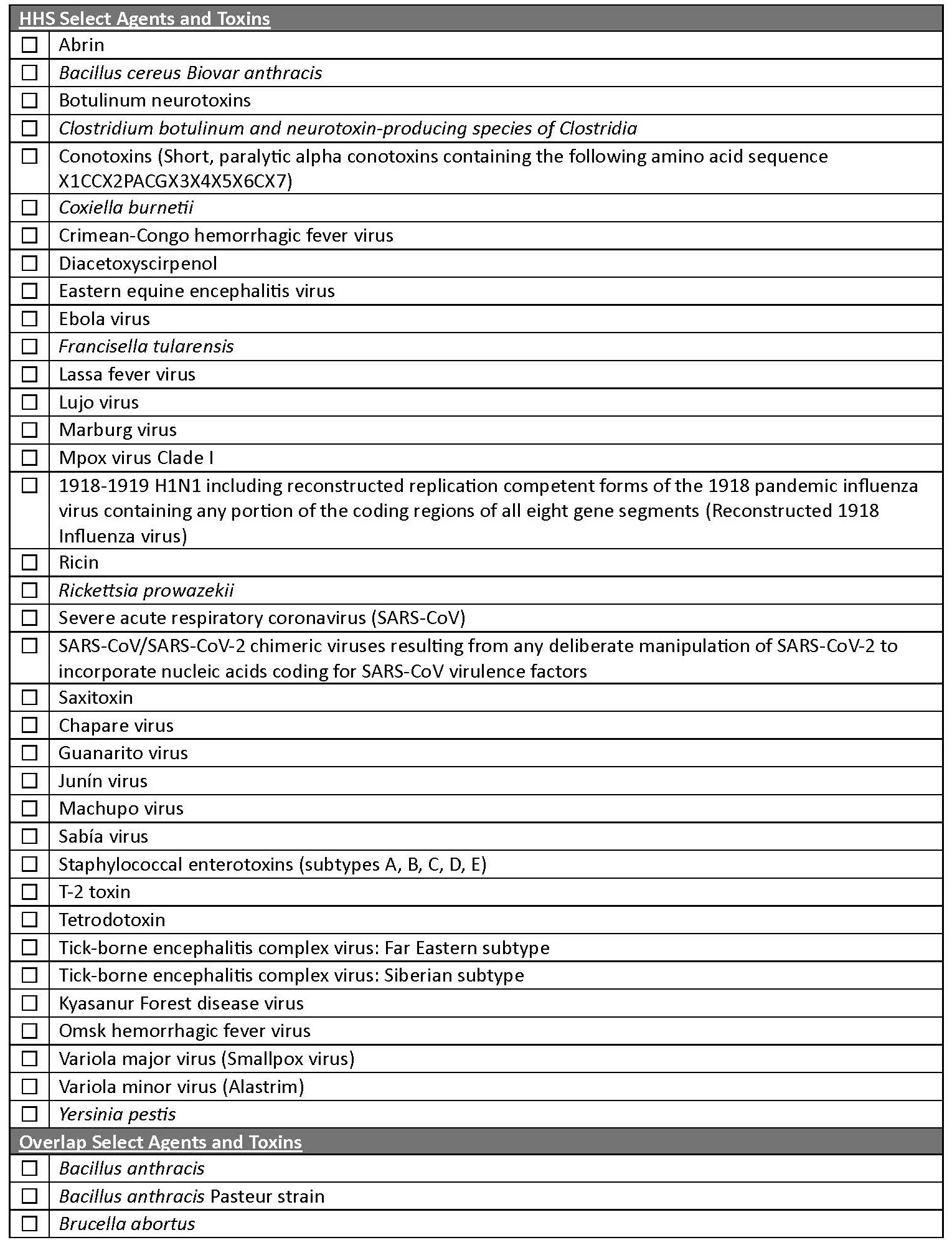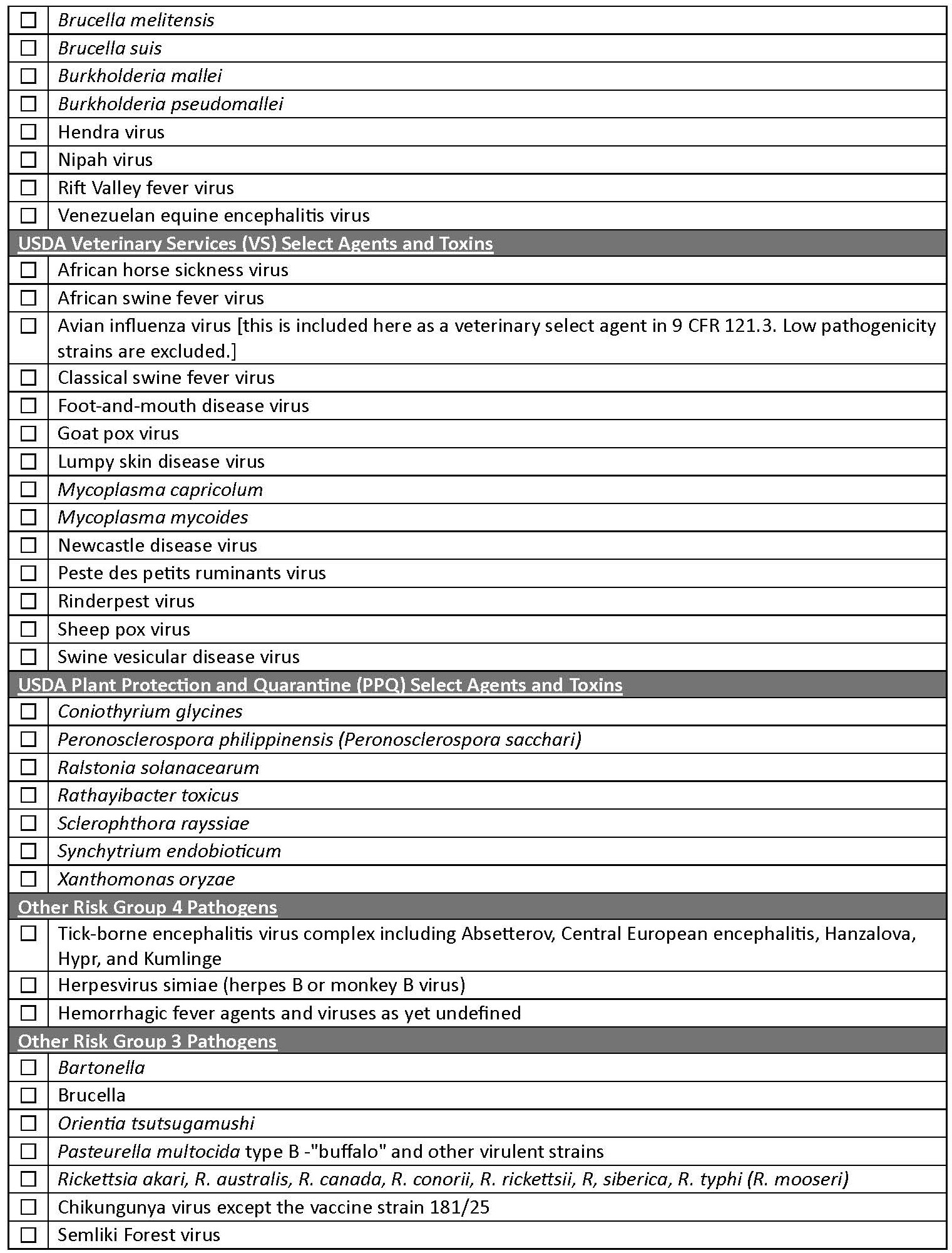Dual Use Research of Concern and Pathogens with Enhanced Pandemic Potential Policy
Updated September 2024
Biosafety Officer: Amy Robison, amanda.robison@montana.edu (406) 994-6733
MSU Office of Research Compliance
Introduction
Research oversight increases the awareness of researchers, institutions, and federal funding agencies about the biosafety and biosecurity concerns associated with certain types of research and to ensure that appropriate risk mitigation measures are in place to prevent biosafety incidents (e.g., unintended personal exposure or release of an agent outside of containment) or biosecurity incidents (e.g., theft or intentional misuse of information, knowledge, products, or technology).
Purpose
The purpose of the United States Government Policy (USG) for Oversight of Dual Use Research of Concern (DURC) and Pathogens with Enhanced Pandemic Potential (PEPP) is to establish a unified federal oversight framework for conducting and managing certain types of federally funded life sciences research on biological agents and toxins that may pose risks to public health, agriculture, food security, economic security, or national security. Research should be assessed for Category 1 or Category 2 oversight at the proposal stage and throughout the full life cycle of the research.
Category 1 research oversight focuses on all Select Agents and Toxins, a subset list of Risk Group 3 agents, and all Risk Group 4 pathogens, (see list of agents at the end of this policy); nine experimental outcomes, and potential DURC.
- DURC is defined as “life sciences research that, based on current understanding, can be reasonably anticipated to provide knowledge, information, products, or technologies that could be misapplied to do harm with no, or only minor, modification to pose a significant threat with potential consequences to public health and safety, agricultural crops and other plants, animals, the environment, materiel, or national security.”
Category 2 research oversight focuses on pathogens that are infectious to humans, and four experimental outcomes that enhance the agent’s infectiousness in humans, that could lead to a potential pandemic.
- A pathogen with pandemic potential (PPP) as defined as a “pathogen that is likely capable of wide and uncontrollable spread in a human population and would likely cause moderate to severe disease and/or mortality in humans.”
- A pathogen with enhanced pandemic potential (PEPP) as defined in the Policy is “a type of PPP resulting from experiments that enhance a pathogen’s transmissibility or virulence, or disrupt the effectiveness of pre-existing immunity, regardless of its progenitor agent, such that it may pose a significant threat to public health, the capacity of health systems to function, or national security. Wild-type pathogens that are circulating in or have been recovered from nature are not PEPPs, but may be considered PPPs because of their pandemic potential.”
- Category 2 oversight is also required for experiments that generate, use, reconstitute, or transfer an eradicated or extinct PPP that may pose a significant threat to public health, the capacity of health systems to function, or national security, regardless of whether the experiment enhances the PPP.
- Current eradicated and extinct PPPs include Variola major and minor, and Influenza A virus subtypes H1N1 (1918) and H2N2 (1957-1968).
Experimental Outcomes
Research within the scope of Category 1 or Category 2 are those experimental outcomes or actions with a pathogen that are reasonably anticipated to:
Category 1
- Increase transmissibility of a pathogen within or between host species;
- Increase the virulence of a pathogen or convey virulence (i.e., the ability of a pathogen to cause disease) to a non-pathogen;
- Increase the toxicity of a known toxin or produce a novel toxin;
- Increase the stability of a pathogen or toxin in the environment, or increase the ability to disseminate a pathogen or toxin (e.g., improving characteristics of the pathogen or toxin such as environmental stability and ability to be aerosolized);
- Alter the host range or tropism of a pathogen or toxin;
- Decrease the ability for a human or veterinary pathogen or toxin to be detected using standard diagnostic or analytical methods;
- Increase resistance of a pathogen or toxin to clinical and/or veterinary prophylactic or therapeutic interventions (e.g., antimicrobials, antivirals, antitoxins, vaccines);
- Alter a human or veterinary pathogen or toxin to disrupt the effectiveness of pre-existing immunity, via immunization or natural infection, against the pathogen or toxin; or
- Enhance the susceptibility of a host population to a pathogen or toxin.
Category 2
- Enhance transmissibility of the pathogen in humans;
- Enhance the virulence of the pathogen in humans;
- Enhance the immune evasion of the pathogen in humans, such as by modifying the pathogen to disrupt the effectiveness of pre-existing immunity via immunization or natural infection; or
- Generate, use, reconstitute, or transfer an eradicated or extinct PPP, or a previously identified PEPP.
Responsibilities and Review Process for Principal Investigators
- Note: It is recommended that PIs begin their review process by considering whether their research may be within the scope of Category 2 first, and then consider Category 1.
- Be knowledgeable of, and comply with, all institutional and USG policies and requirements for Category 1 or Category 2 oversight.
- Assess whether research involves, or is reasonably anticipated to result in, a PPP and one or more of the experimental outcomes or actions in the scope of Category 2.
- Assess whether research involves one or more of the biological agents or toxins and experimental outcomes in the scope of Category 1.
- Notify the IBC at the proposal stage, and continuously throughout the research lifecycle, when the research involves one or more of the listed agents or toxins and/or experimental outcomes.
- Notify the federal funding agency.
- Work with the Biosafety Officer and the IBC to develop and submit risk-benefit assessments and risk mitigation plan to the federal funding agency.
- Conduct research in accordance with the approved risk mitigation plan and applicable regulations, policies, and guidelines.
If research does not meet Category 1 or Category 2 criteria, the PI must continually assess their research for any changes that may alter the assessment of whether the research is in the scope of Category 1 or Category 2.
Responsibilities and Review Process of the Institutional Biosafety Committee
MSU’s Institutional Biosafety Committee (IBC) acts as the Institutional Review Entity (IRE).
- Note: It is recommended that IREs begin their review process by considering whether their research may be within the scope of Category 2 first, and then consider Category 1. These key actions and responsibilities do not necessarily need to be implemented sequentially.
- Confirm the PI’s assessment that research involves, or is reasonably anticipated to
result in, a PPP and one or more of the experimental outcomes or actions in the scope
of Category 2.
- Assess risks and determine whether research is Category 2.
- Assess research for dual-use risks.
- Confirm PI’s assessment that research involves one or more of the biological agents and toxins and experimental outcomes in the scope of Category 1.
-
- Assess research for dual-use risks.
- Determine whether research is Category 1.
- Notify the federal funding agency of IBC determination.
- Provide education and training for individuals conducting DURC, as needed.
- Develop and submit risk-benefit assessments and risk mitigation plan to the federal funding agency.
- Oversee federally funded research in accordance with approved risk mitigation plan and applicable regulations, policies, and guidelines.
- Maintain records of institutional Category 1 and Category 2 research reviews and complete risk mitigation plans for at least three years after the completion of the funded project unless a longer period is required by law or regulation.
If the research does not meet Category 1 or Category 2 criteria, the IBC continually assesses research for any changes that may alter an assessment of whether research is Category 1 or Category 2.
Strategies for Mitigating DURC Associated Risks
The IBC will determine whether existing biosafety and biosecurity measures are adequate or warrant additional biosafety and security measures. The USG DURC-PEPP Policy and the Implementation Guidance provide examples of enhanced biosafety and biosecurity measures.
Reporting
Within 30 calendar days of the institutional review, the IBC must notify the federal funding agency of any research within the scope, including whether it meets or does not meet the definition of Category 1 or Category 2 research. Within 90 calendar days from when the research institution determines the research to be Category 1 or Category 2 research, the IBC provides a copy of the risk mitigation plan to the federal funding agency for review.
Resources
Catergory 1 Agents



